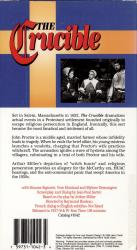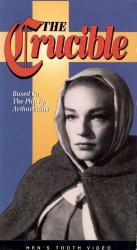The Crucible
Catalog Number
1042
-
Primary Distributor (If not listed, select "OTHER")
Catalog Number
1042
Primary Distributor (If not listed, select "OTHER")
Release Year
Country
108 mins (NTSC)
N/A | N/A | English
N/A | N/A
The Witches of Salem (1957)
Additional Information
Additional Information
American playwright Arthur Miller was still under an "unfriendly" cloud in 1958, so far as the anti-Communist brigades were concerned. Thus, the film version of Miller's stage play The Crucible was lensed in France. Drawing several parallels to the McCarthy era, Miller dramatizes the Salem Witch Trials of the late 17th century, when hearsay, rumor, and mass hysteria passed for hard evidence. Given an opportunity to escape being hanged for witchcraft, John Proctor (Yves Montand) refuses to bow to the demands of the so-called justices. Many observers felt that this climactic scene was an act of contrition for Arthur Miller, who was (by his reasoning) not nearly so courageous when grilled by the HUAC. Also known as The Witches of Salem, The Crucible was adapted for the screen by Jean-Paul Sartre.
The Crucible (French: Les Sorcières de Salem, German: Die Hexen von Salem or Hexenjagd) is a 1957 joint Franco-East German film production directed by Raymond Rouleau with a screenplay adapted by Jean-Paul Sartre from the 1953 play The Crucible, by Arthur Miller. The film was only briefly released on home video, and is extremely difficult to find.
1692, Salem, Massachusetts. John Proctor is the only member in the town's assembly who resists the attempts of the rich to gain more wealth on the expense of the poor farmers, thus incurring the wrath of deputy governor Danforth. Proctor's sternly puritanical wife, Elizabeth, is sick and has not shared his bed for months, and he was seduced by his maid, Abigail. When he ends his affair with her, Abigail and several other local girls turn to slave Tituba. Reverend Parris catches the girls in the forest as they partake in what appears to be witchcraft. Abigail and the rest deny it, saying that they have been bewitched. A wave of hysteria engulfs the town, and Danforth uses the girls' accusations to instigate a series of trials, during which his political enemies are accused of heresy and executed. When Abigail blames Elizabeth Proctor, the latter rejects John's pleas to defraud Abigail as an adulteress. Eventually, both Proctors are put on trial and refuse to sign a confession. The townspeople rebel, but not before John is hanged with other defendants; his pregnant wife has been spared. Elizabeth tells the angry crowd to let Abigail live.
Les Sorcières de Salem sold 1,686,749 tickets.[7] For their appearance in it, Signoret won the 1957 BAFTA Award for Best Foreign Actress and Mylène Demongeot was nominated for the BAFTA Award for Best Newcomer in the same year.[8] In the 1957 Karlovy Vary International Film Festival, the Best Actor Award was given to "all actors of Les Sorcières de Salem in collective, and especially to Yves Montand."[9]
The New York Times' critic Bosley Crowther wrote that "out of The Crucible... Jean-Paul Sartre and Raymond Rouleau have got a powerful and compelling film... For now Mr. Miller's somewhat cramped and peculiarly parochial account... comes forth as a sort of timeless drama... This is a persistently absorbing film."[10] The Time magazine's reviewer commented that "Witches of Salem is a foredoomed but fascinating attempt... But it hardly helps the scriptwriter's case... When he sums the whole story up as an early American instance of class warfare."[11]
Michel Contat and Michel Rybalka, who edited and annotated Sartre's writings, noted that he introduced a strong element of communist class struggle into his adaptation of Miller's play, especially by turning Danforth from merely sanctimonious to a calculated villain who pulls the strings behind the trial, while making the character of Abigail more complex and consequently, almost sympathetic.[12] In the introduction to the 2010 edition of The Crucible, editor Susan C. W. Abbotson described the film's plot as a "conflict between capitalists and heroic Marxists", writing that "Miller felt the Marxist references were too heavy-handed. Most critics agreed."[13] Abbotson also commented that "Sartre changed the play's theme... His version becomes despiritualized... As it desires to present us the heroic representatives of Communism."[14] In another occasion, Miller told that he disliked the film because it "reduced man to a digit in the socialist dialectic."[15]
According to Susan Hayward, the picture's release shortly after the crushing of the 1956 Hungarian Uprising by the Soviets caused several critics to attack it as a work of pro-communists, who resisted Joseph McCarthy and the French War in Algeria but supported the Kremlin. Hayward, however, viewed it as standing in favor of the right to exercise free speech in general.[7]
Release Date: December 7, 1958
The Crucible (French: Les Sorcières de Salem, German: Die Hexen von Salem or Hexenjagd) is a 1957 joint Franco-East German film production directed by Raymond Rouleau with a screenplay adapted by Jean-Paul Sartre from the 1953 play The Crucible, by Arthur Miller. The film was only briefly released on home video, and is extremely difficult to find.
1692, Salem, Massachusetts. John Proctor is the only member in the town's assembly who resists the attempts of the rich to gain more wealth on the expense of the poor farmers, thus incurring the wrath of deputy governor Danforth. Proctor's sternly puritanical wife, Elizabeth, is sick and has not shared his bed for months, and he was seduced by his maid, Abigail. When he ends his affair with her, Abigail and several other local girls turn to slave Tituba. Reverend Parris catches the girls in the forest as they partake in what appears to be witchcraft. Abigail and the rest deny it, saying that they have been bewitched. A wave of hysteria engulfs the town, and Danforth uses the girls' accusations to instigate a series of trials, during which his political enemies are accused of heresy and executed. When Abigail blames Elizabeth Proctor, the latter rejects John's pleas to defraud Abigail as an adulteress. Eventually, both Proctors are put on trial and refuse to sign a confession. The townspeople rebel, but not before John is hanged with other defendants; his pregnant wife has been spared. Elizabeth tells the angry crowd to let Abigail live.
Les Sorcières de Salem sold 1,686,749 tickets.[7] For their appearance in it, Signoret won the 1957 BAFTA Award for Best Foreign Actress and Mylène Demongeot was nominated for the BAFTA Award for Best Newcomer in the same year.[8] In the 1957 Karlovy Vary International Film Festival, the Best Actor Award was given to "all actors of Les Sorcières de Salem in collective, and especially to Yves Montand."[9]
The New York Times' critic Bosley Crowther wrote that "out of The Crucible... Jean-Paul Sartre and Raymond Rouleau have got a powerful and compelling film... For now Mr. Miller's somewhat cramped and peculiarly parochial account... comes forth as a sort of timeless drama... This is a persistently absorbing film."[10] The Time magazine's reviewer commented that "Witches of Salem is a foredoomed but fascinating attempt... But it hardly helps the scriptwriter's case... When he sums the whole story up as an early American instance of class warfare."[11]
Michel Contat and Michel Rybalka, who edited and annotated Sartre's writings, noted that he introduced a strong element of communist class struggle into his adaptation of Miller's play, especially by turning Danforth from merely sanctimonious to a calculated villain who pulls the strings behind the trial, while making the character of Abigail more complex and consequently, almost sympathetic.[12] In the introduction to the 2010 edition of The Crucible, editor Susan C. W. Abbotson described the film's plot as a "conflict between capitalists and heroic Marxists", writing that "Miller felt the Marxist references were too heavy-handed. Most critics agreed."[13] Abbotson also commented that "Sartre changed the play's theme... His version becomes despiritualized... As it desires to present us the heroic representatives of Communism."[14] In another occasion, Miller told that he disliked the film because it "reduced man to a digit in the socialist dialectic."[15]
According to Susan Hayward, the picture's release shortly after the crushing of the 1956 Hungarian Uprising by the Soviets caused several critics to attack it as a work of pro-communists, who resisted Joseph McCarthy and the French War in Algeria but supported the Kremlin. Hayward, however, viewed it as standing in favor of the right to exercise free speech in general.[7]
Release Date: December 7, 1958
Related Links
1
0






Comments0
Login / Register to post comments